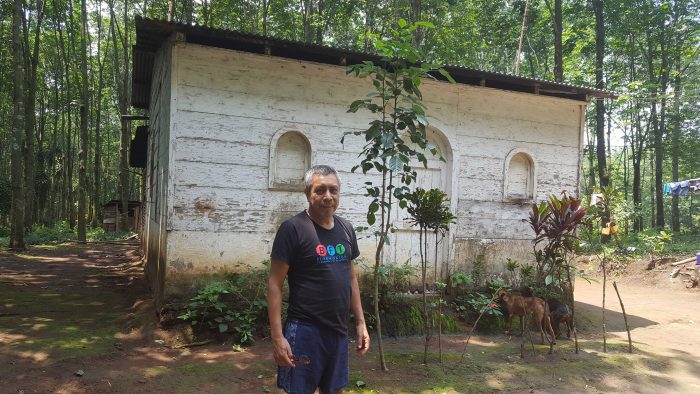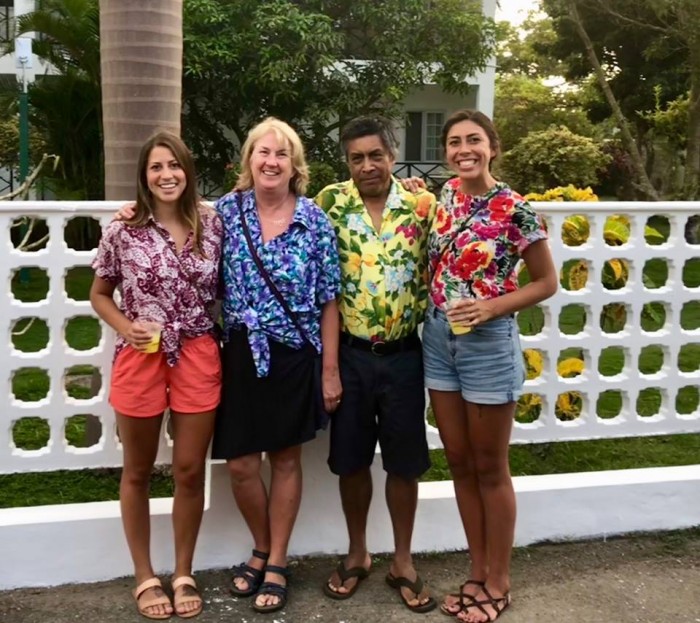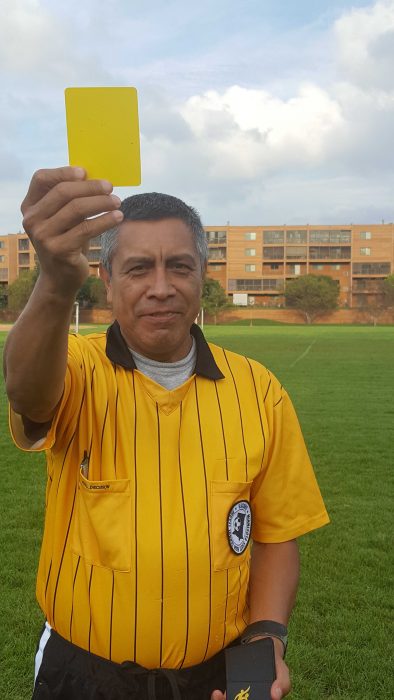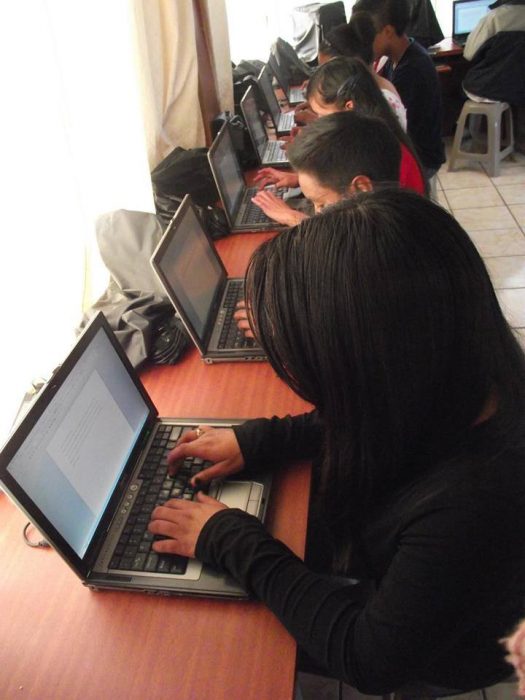| Our Mission | About Guatemala | References & Reviews |
| Videos | Spanish Methodology | |
| CX Spanish Teachers | Current Events | Going Green |
About Casa Xelaju
Casa Xelaju was established in 1987.
Julio E. Batres interview about Casa Xelaju Spanish school in Quetzaltenango, Guatemala.
The history of Casa Xelajú is one built on trial and error with visions of a better future for Guatemala and an international awareness of Guatemala’s political, social, and cultural situation.
The seeds of the school were sown in the midst of some of the worst years of the nation’s civil war in the 1980s, at a time when tourists were a rarity in the country.
The school’s founder Julio E. Batres moved to Quetzaltenango, Guatemala in 1974 to attend his last year of high school.
Originally from Aldea Francisco Vela, a small farming community of about 2,000 people located outside of the San Felipe municipality, he got into trouble in his high school in Retalhuleu for participating in a teacher’s strike, one of which the teachers lost.
The school administration saw him as a trouble maker and various administrators told him that he would never graduate from the Institute. Wanting to pursue his education in the hopes to make a life with more opportunities, he finished up his high school education in Quetzaltenango.
After high school, he enrolled in Universidad de San Carlos, studying Law for 4 years. While studying in the university he began to better understand the political situation that was such a serious issue for Guatemala and started to become more politically active.
He joined the Law Student Association (Asociacion de Estudiantes de Derecho) which was doing a lot of work with helping organize and advise worker unions as well as holding demonstrations and protests against the military and the war.
Start of a Dream
In 1979 he decided to move to the United States. First of all, he lost his job and figured that that was the time to move. However, his move was also motivated by the fact that he didn’t feel safe living in Guatemala.
He “lost a lot of friends, classmates, and professors who were killed by the Guatemalan army” and through his involvement with a group such as the Law Students Association he was worried that he might succumb to a similar fate.
In the mid-1980s, while attending the University of Milwaukee and working part-time with the Milwaukee school system in the United States, he got the idea to open a Spanish language school in Guatemala, choosing Quetzaltenango as the location.
In January of 1986, Vinicio Cerezo became Guatemala’s first democratically elected and civilian president in 1966. Julio saw this as a political opening for the country giving way to the “right conditions to attract students to the beauty of Guatemala”.
Then in 1987, he decided to go to Guatemala to begin organizing for the school. With around $1,000 saved up to start the school, he arrived in Guatemala to open Casa de Español Xelajú (the original name of the school), officially accepting students in December of 1987.
When asked how he first got students to attend the school, he laughed and began to tell his publicity story. Julio knew that he didn’t have much money to start a school, much less to do publicity, so he bought two boom-boxes in the U.S. and carried them on his flight to Guatemala.
However, the flight had a stop in Mexico City where the police gave him problems for carrying the small stereos.
They put him in jail for 30 minutes and eventually let him go, though confiscating one boom-box. Upon his arrival in Quetzaltenango, he sold the remaining boom-box to do publicity and rent a house.
Birth of Casa Xelajú
In the beginning, there were only 2 employees, Julio and his sister Rosa Alicia, who was a teacher and in charge of recruiting and training other teachers.
Their original dream was to have “ten students, 5 in the morning and 5 in the afternoon”, he stated with a grin of remembrance. However, Julio did not just simply want to teach Spanish, he wanted students to understand and truly get to know Guatemala.
The school began by working together with the Guatemalan solidarity movement in the U.S., to stop the U.S. military, economic, and political support of the Guatemalan army.
They sought to educate U.S. citizens about some of the things that were going on in the country and many of its first students were people working on the solidarity movement who needed to learn Spanish.
Same as today, the classes then were accompanied by daily cultural and social activities such as lectures and trips to unions and other popular organizations around Quetzaltenango.
Trying to help the general community of Guatemala, the first students also did volunteer work with the unions and human rights organizations. The school sent some students to work with the organizations after school, helping to integrate computers in their
work and demonstrating the use of the computers and the advantages of using them in their work because “at that time computers weren’t popular, there weren’t many organizations that had computers in the offices.”
Other student volunteers did construction work, which was very informal. In 1989 six students were invited to help in the construction of a road in Canton Francisco Vela.
For years there had been problems with the road, which was originally and still mostly just dirt, and during the winter (rainy season) the rainwater creates huge holes and it is impossible to get around.
The students came to the canton and helped the local community committee, working for four hours on Saturday and returning to Quetzaltenango on Sunday for classes on Monday.
Not too long after, the school decided that a community project was necessary closer to the school itself. Asked about the beginning of La Pedrera, which started about 13 years ago, Julio admits that he himself did not discover it.
“We were looking for a community to help and a teacher, Magdalena Salazar, was working on a project for the university and had some kind of contact and experience with La Pedrera.”
After visiting the community and talking to its members, they started a very informal relationship with the people, and “eventually we were just engaged with them”.
The Boom of Spanish Schools
He acknowledged that in the beginning business was slow. “You have to take into consideration that there were few tourists in
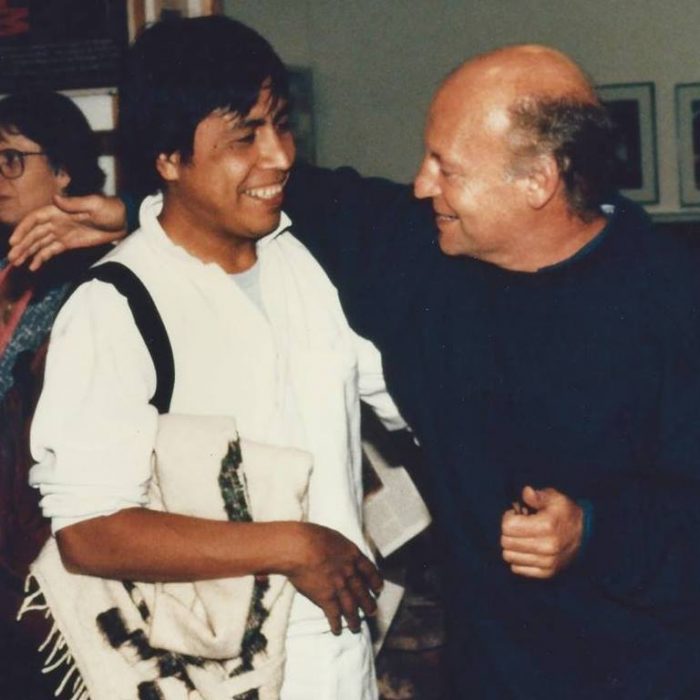
Julio E. Batres and Uruguayan writer Eduardo Galeno., Spanish School in Quetzaltenango, Spanish School in Quetzaltenango, Spanish School in Quetzaltenango, Spanish School in Quetzaltenango
Guatemala at this time because of the political repression. In the late 1970s, there were a couple of Spanish schools in Xela [nickname for Quetzaltenango] but they had to close down because of the civil war.”
Though there were former teachers giving classes from home, there were no other official language schools at the time.
However, as months went by business slowly began to pick up. Starting off by targeting people from the U.S. working on Latin American solidarity movements (from organizations such as NISGUA, CISPES, and the solidarity movement of Nicaragua), they broadened their clientele to include Spanish teachers in the United States and university students.
The school went from having 15 students per week in the summer to 40 per week, steadily growing. As a result of the growth, they had to begin to rent 2 buildings in the summer instead of just one.
In 1995, Julio decided to begin looking for land in the city to build the foundations of the school. When asked about the location he stated, “Everyone said it was a dump and very ugly.
It was on the market for 2 years. It had a lot of rocks.” At first, he was scared to buy the land because he didn’t have much money, not receiving a salary from the school but working in the U.S. to make money to pay the bills.
Again with a grin of remembering the early days, he explained one form of making money for the school:
“I would buy inexpensive cars in the U.S. and drive them from Milwaukee to Guatemala and sell them to pay for the land. I had a summer break from teaching in the States.
We knew we had to buy land because the owner of the place we were renting was charging us more and more per month because she thought that we were making a lot of money.”
In 1989 they really began to increase the number of students due to their construction of the school’s website. By using America Online, Juan Carlos Aguilar, who was also a teacher at the school, developed the original website of Casa de Español Xelajú.
He talked to a lot of students about the technology and how to design it and was eager to learn about the technology, “I think he was the first webmaster in Quetzaltenango”, stated Julio.
A few last Words
In January of 2007, I was able to visit Julio’s home in Francisco Vela and speak with him on the history of the school which is where I got the majority of my information.
After learning about the history of the school, I was interested in finding out some of his personal beliefs about the school in general and the future of Casa Xelajú. First and foremost, his main hope is that the students receive the best linguistic experience possible.
He does this by providing good teachers as well as a good learning environment. The school was specifically designed for one-on-one language instruction with three floors, each containing individual rooms to avoid interruptions.
In addition, the school also has a patio, mirador, and free internet access (including wireless connection).
The classes are augmented by the host family experience and daily activities which provide for the practical use of the Spanish studies. He continued saying, “As a teacher, I have a clear understanding that you don’t fully learn a language, without learning the culture and history; they are embedded.”
Julio then told me that, besides providing a great learning experience, he is dedicated to providing job security with benefits and a good salary to the teachers and families.
Accepting that the prices for his school might be a bit higher than some other schools, he points out, “When you pay benefits, your costs go up” and that the school pays a higher salary to both the teachers and families than the vast majority of schools in Quetzaltenango.
In terms of the future of Casa Xelajú, Julio hopes to get more stability for the school. He mentions that they get a lot of students in the summer, but that it is important for the teachers to have continuous work throughout the year.
He said that he is expanding the Spanish program a bit, designing courses to pass specific Spanish tests (Praxis, Texas Oral Proficiency Test, OPI, Foreign Service Institute Test, etc.), Spanish for Lawyers, Spanish for Health Care Workers, and Spanish Online classes.
He also would like to reach the European countries, realizing that it might help stretch out the business so as to not just have a heavy load of students in the summer months.
The conversation ended with him saying that he would also like to fund a school where he was born “to bring more education to the country and bring internet there. I truly believe that education is a tool to help liberate people from poverty.”
Written by J. Matt Wendling in January 2007
